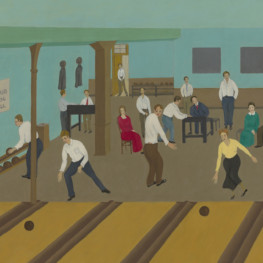Wood Gaylor
1883-1957
Wood Gaylor was born in Stamford, Connecticut in 1883. His artistic training began in 1909, when he enrolled for a year at the National Academy of Design. In 1912, Gaylor began studying with Walt Kuhn at his art school in Fort Lee, NJ; Kuhn would be an important influence in Gaylor’s life. The next year (1913), Kuhn and his committee opened the groundbreaking Armory show, in which Gaylor exhibited two works. The bond between Gaylor and Kuhn grew as they organized the rambunctious Penguin club and important exhibitions. Through these associations Gaylor befriended Arthur B. Davies, Jules Pascin, and many other artists.
At about the same time, Gaylor met Hamilton Easter Field and Robert Laurent. Their friendship grew during the summers they spent at Field’s artist colony in Ogunquit, Maine where Gaylor extended his artistic network. Among other artists associated with this group, Gaylor befriended Yasuo Kuniyoshi, and William and Marguerite Zorach. This milieu was deeply committed to collecting American Folk Art and Gaylor, always a collector, began to collect in this area as well. There was much overlapping between Gaylor’s circles, particularly through the non-juried innovative American exhibitions, such as the Salons of America. With the early and untimely death of Field in 1922, Gaylor joined Laurent and others to form the Hamilton Easter Field Foundation where he served as Vice President for decades, continuing Field’s mission to support the work of promising young artists.
Gaylor was experimental in his early etchings and carvings, and the influence of Gauguin, Matisse, Davies and Laurent is palpable. Well-trained and completely immersed in modernist artistic styles, however, Gaylor’s mature style is uniquely his own. Flat areas of blocked color, and crowded scenes recording events and moments he witnessed, are hallmarks of his work. His simplified figures, love of flags, and quotidian details earned him the title of “primitivist” during the first half of the twentieth century. Comparisons to Grandma Moses and Horace Pippin are apt in many ways, but as an art “insider” par excellence Gaylor’s style is in many ways more comparable to Florine Stettheimer’s, yet his bold colors and witty approach to documenting events ultimately distinguish him.
Works by Wood Gaylor are in the public collections of many major art museums, including the Whitney Museum of Art (New York), the Smithsonian American Art Museum (Washington D.C.), and the Portland Museum of Art (Maine). He died in 1957.


